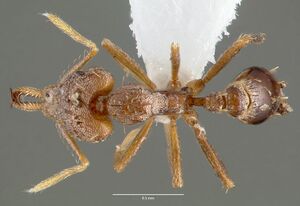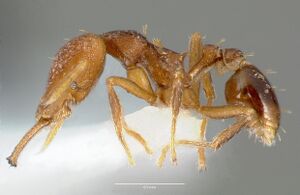Strumigenys lysis
| Strumigenys lysis | |
|---|---|

| |
| Scientific classification | |
| Kingdom: | Animalia |
| Phylum: | Arthropoda |
| Class: | Insecta |
| Order: | Hymenoptera |
| Family: | Formicidae |
| Subfamily: | Myrmicinae |
| Tribe: | Attini |
| Genus: | Strumigenys |
| Species: | S. lysis |
| Binomial name | |
| Strumigenys lysis Fisher, 2000 | |
The more than a dozen records of this species are primarily from montane forest and rainforest but there are also collections from a dwarf litoral forest and a park/garden. Most specimens have been found via litter sampling with a few being noted as coming from a rotten log, under a log and in a root mat.
Identification
Bolton (2000) - A member of the lysis complex in the Strumigenys arnoldi-group. S. lysis is easily separated from other members of the complex by the presence of a projecting laminar rim on upper scrobe margin throughout its length, a single pair of erect hairs on mesonotum, and the dorsolateral margin of the head posteriorly without 2-4 stiff erect hairs that are longer than hairs on leading edge of scape.
Keys including this Species
Distribution
Latitudinal Distribution Pattern
Latitudinal Range: -14.75° to -14.75°.
| North Temperate |
North Subtropical |
Tropical | South Subtropical |
South Temperate |
- Source: AntMaps
Distribution based on Regional Taxon Lists
Malagasy Region: Madagascar (type locality).
Distribution based on AntMaps
Distribution based on AntWeb specimens
Check data from AntWeb
Countries Occupied
| Number of countries occupied by this species based on AntWiki Regional Taxon Lists. In general, fewer countries occupied indicates a narrower range, while more countries indicates a more widespread species. |

|
Estimated Abundance
| Relative abundance based on number of AntMaps records per species (this species within the purple bar). Fewer records (to the left) indicates a less abundant/encountered species while more records (to the right) indicates more abundant/encountered species. |

|
Biology
|
Castes
Worker
Images from AntWeb
   
| |
| Holotype of Strumigenys lysis. Worker. Specimen code casent0005597. Photographer April Nobile, uploaded by California Academy of Sciences. | Owned by MCZ, Cambridge, MA, USA. |
   
| |
| Paratype of Strumigenys lysis. Worker. Specimen code casent0005598. Photographer April Nobile, uploaded by California Academy of Sciences. | Owned by CAS, San Francisco, CA, USA. |
   
| |
| Paratype of Strumigenys lysis. Worker. Specimen code casent0005599. Photographer April Nobile, uploaded by California Academy of Sciences. | Owned by CAS, San Francisco, CA, USA. |
Nomenclature
The following information is derived from Barry Bolton's Online Catalogue of the Ants of the World.
- lysis. Strumigenys lysis Fisher, in Bolton, 2000: 664 (w.q.) MADAGASCAR.
Unless otherwise noted the text for the remainder of this section is reported from the publication that includes the original description.
Description
Worker
Holotype. TL 2.9, HL 0.70, HW 0.57, CI 81, ML 0.39, MI 56, SL 0.47, SI 83, PW 0.34, AL 0.73. Characters of lysis-complex. Each mandible with 2 preapical teeth, situated in the apical third; proximal preapical tooth longer than distal. Upper scrobe margin bordered by a narrow laminar rim. Eyes small, convex and plainly visible in full-face view; maximum diameter of eye subequal to maximum width of scape. Scape short, curved near base, widest in the midsection; hairs on leading edge fine, slightly flattened or spoon-shaped apically. Cephalic dorsum densely clothed with short curved narrowly spatulate to flattened scale-like ground-pilosity; upper scrobe margin fringed with curved narrowly spatulate hairs. Cephalic dorsum with 4 stout standing hairs arranged in a transverse row close to the occipital margin and a more anteriorly situated pair on vertex. Dorsum of head reticulate-punctate with superimposed rugulose sculpture on middorsum and occipital angles. Pronotal humeral hair stiffly filiform; humeral angles rounded. Anterior margin of mesonotum with a pair of stout filiform hairs. Propodeum with one pairs of short, fine, posteriorly curved hairs at anterior base of propodeal spines. Alitrunk dorsum with short curved filiform to narrowly spatulate ground-pilosity. Dorsum of alitrunk in outline convex anteriorly, posterior alitrunk more or less flat to gradually sloping down to declivity. Metanotal groove shallowly impressed. Anterior mesonotum without a distinct carina above the mesothoracic spiracle. Propodeal spines narrowly triangular, spongiform apex, subtended by a very narrow lamella on declivity. Pronotum densely punctate with longitudinally striolate to costulate sculpture. Remainder of dorsal alitrunk reticulate-punctate, but in some the striolate or costulate sculpture continues to the propodeum. Pleurae smooth and shiny with peripheral punctures. Petiole node in dorsal view about as broad as long. Postpetiole disc longitudinally striolate on a finely punctulate surface, but in some, the punctulate sculpture is absent or weak. In profile ventral spongiform tissue of petiolar peduncle a well developed strip along the base of the peduncle, depth of strip more or less equal to the width of the mandible blade when viewed in profile and slightly less than maximum width of eye. Ventral spongiform lobe of postpetiole moderately developed. Basigastral costulae short and distinct. Dorsal surface of petiole with one pair of anteriorly proj ecting narrowly remiform hairs; postpetiole and gaster with stout standing narrowly remiform hairs. Colour light to medium brown.
Paratypes. TL 2.8-3.0, HL 0.68-0.73, HW 0.54-0.60, CI 77-88, ML 0.37-0.40, MI 53-58, SL 0.45-0.51, SI 82-87, PW 0.32-0.36, AL 0.69-0.80 (9 measured). As holotype.
Measurements of this material extend the range shown by the type-series: HL 0.67-0.74, HW 0.53-0.60, CI 79-81, ML 0.35-0.40, MI 53-54, SL 0.45-0.49, SI 82-85 (2 measured).
Type Material
Holotype worker, Madagascar: 6.5 km. SSW Befingotra, Res. Anjanaharibe-Sud, 14°45'S, 49°30'E, 875 m., 19.x.1994, sifted litter (leaf mold rotten wood), rainforest #1070 (9)-14 (B. L. Fisher) (Museum of Comparative Zoology).
Paratypes. 9 workers and 1 queen (dealate) with same data as holotype but coded (3)-13, (6)-10, (8)-10, (10)-10, (29)-20, (37)-6. (The Natural History Museum, South African Museum).
References
- Fisher, B.L. 2000. The Malagasy fauna of Strumigenys. Pp. 612-696 in: Bolton, B. 2000. The ant tribe Dacetini. Memoirs of the American Entomological Institute. 65:1-1028. (page 664, worker described)
References based on Global Ant Biodiversity Informatics
- Bolton, B. 2000. The Ant Tribe Dacetini. Memoirs of the American Entomological Institute 65
- Fisher B. L. 2003. Formicidae, ants. Pp. 811-819 in: Goodman, S. M.; Benstead, J. P. (eds.) 2003. The natural history of Madagascar. Chicago: University of Chicago Press, xxi + 1709 pp.

